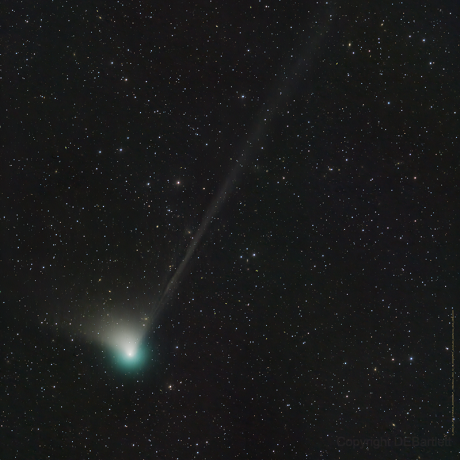
A comet will appear in the night sky for the first time since the last ice age, offering scientists a look at the progression of the solar system.
Key Facts
A bright green comet—named C/2022 E3 (ZTF)—will pass by Earth for the first time in 50,000 years and will first pass by the Sun, arriving from the outer parts of the solar system, which is why it’s taken thousands of years to return.
C/2022 E3 ZTF hasn’t made an appearance since the Upper Paleolithic period, which is the time Neanderthals and early Homo sapiens roamed the Earth, according to Space.
The comet will be the closest to Earth on February 1, and the closest to the Sun on January 12, and although its brightness is unpredictable, by then it will only be visible to the naked eye in dark skies, according to NASA.
It’s northbound, heading toward the constellation Corona Borealis, so for those in the Northern Hemisphere, C/2022 E3 (ZTF) will be visible on January 12 between the stars Vega and Arcturus just before midnight with the help of telescopes and binoculars.
For first-time comet gazers, experts recommend looking out on February 10 when the comet will be close to Mars, and for those who want to try and capture a photo, the easiest way would be to take long-exposure pictures of 20 to 30 seconds, likely revealing a fuzzy object with a tail, according to EarthSky.
The comet was discovered in March 2022 by astronomers using a wide-field survey camera and the Samuel Oschin robotic telescope from the Zwicky Transient Facility in southern California.
Where To Watch
Virtual Telescope Project will be hosting a livestream on their website and YouTube channel for perihelion (when it will be closest to the Sun) and perigee (when it will be closest to Earth).
What’s To Learn
Comet’s are believed “to have originated early in the solar system history,” Dr. Roger Clark, a senior scientist at the Planetary Science Institute, told Forbes. The outermost parts of the solar system are frozen, and because the comet is arriving from this area, it will be made up of material from this region, like dust and water and carbon dioxide ice. When the comet nears the Earth and Sun, scientists will be able to examine these components and learn about the evolution of the solar system from 50,000 years ago, when the comet last arrived. The James Webb Telescope will be watching the comet, but it won’t take any pictures, Nicolas Biver, an astrophysicist at the Paris Observatory, told France 24. Instead, it will examine the composition and determine the solar system’s evolution based on the comet’s material. The heat from the Sun melts the comet’s layers, so the closer it gets, the better scientists can study its makeup.
How Comet C/2022 E3 (ztf) Got Its Name
Astronomers discovered the comet on March 2, 2022, and it was the third object found in the fifth half-month of the year. Half-months are used in astronomy to separate months in two sections: day one through the 15 day, and day 16 through the rest of the month. Each half month is associated with a letter. For example, January 1 through Jan 15 is A, January 16 through January 31 is B, February 1 through Febuary 15 is C and so on. When objects such as asteroids and comets are discovered, they’re given an alphabetical label to distinguish when they were discovered. So, March 2 falls into E, thus explaining 2022 E3. Because it was discovered at the Zwicky Transient Facility, this explains the (ZTF) portion of the comet’s name, according to EarthSky.
Surprising Fact
Contrary to popular belief, comets aren’t fiery balls flying through the sky. According to Clark, comets are “dirty ice balls.” They’re made up of several compounds, such as dry ice, mineral grains and carbon dioxide. Most comets have two tails: a dust tail that’s bluish in color and an ion tail that’s yellowish. Comet tails always point away from the Sun, according to the Laboratory for Atmospheric and Space Physics at the University of Colorado at Boulder.
Via: FORBES









